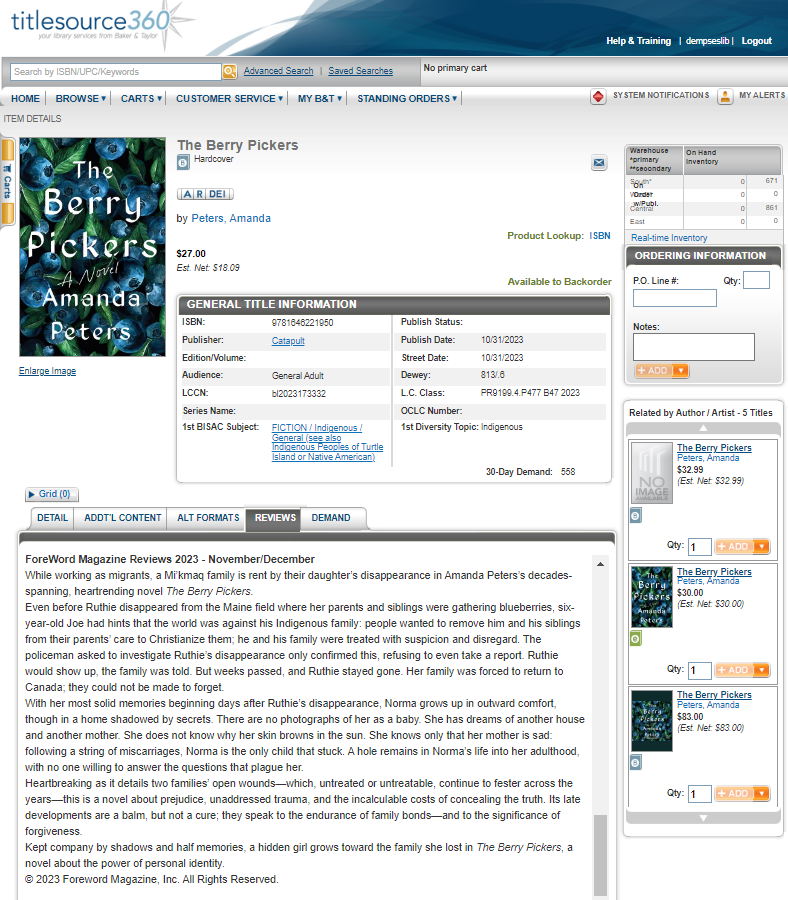There is a lot of space devoted to the value of “trade” reviews at publishing conferences and newsletters. Trade journals are the magazines in print and online that are dedicated to professionals in publishing who use reviews to do their jobs. In this case, librarians and booksellers who depend on these review journals to help them decide which books to add to their purchase orders. Among the notable sources trusted by the trade are Booklist, Foreword, Horn, Kirkus, Library Journal, Publishers Weekly, School Library Journal, and Shelf Awareness.
In these discussions, I often hear a point that is usually glossed over and yet it is probably the most important in terms of sales for publishers: These journals license their review content to wholesaler databases where booksellers and librarians buy books. Ingram’s iPage, Baker & Taylor 360, BowkersBooksInPrint, Brodart, Cengage, and many others get a (daily, weekly, or monthly) data feed from most of these trade journals of their latest book reviews. Shortly thereafter, the trade reviews are listed in the subscriber databases of each wholesaler. This includes both reviews that appear free and the fee-for-review products sold by most journal publishers.

Sample of a review in a wholesale database. (Photo courtesy of Baker & Taylor 360.)
I recently took part in a demo from iPage with my staff, which served as an informative guide for what all the databases provide for their users. In addition to ensuring that your titles continue to be submitted in a timely fashion to these review sources, a couple of items came up that I thought worth thinking about when preparing your submission package.
- Book-banning efforts around the country have made it particularly difficult to do business as usual in many states. But even prior to that unfortunate chain of events, librarians are required to show two or three reviews of a title before they can add it to their purchase orders. In most databases, full reviews of the book from all sources are listed under the metadata.
- Starred reviews are important for any title. Sometimes the starred review is sorted to the top of the list of reviews in the database. Other times it is included in a “listicle” that the database vendor provides to make librarians’ and booksellers’ jobs easier. Our demo included lists curated by iPage like the top 20 indies fiction titles, recent starred reviews, LGBTQ+ fiction, romance, and other high-demand genres.
- These databases are data-driven. While that might sound banal, it is worth noting. For example, if you submit your paperback metadata (ISBN) to review sources and your hardcover metadata (ISBN) is what you submitted to wholesalers, your review will not show up in the system. In other words, it will become an orphan in the journals upload cloud. BISAC codes are also critical. Metadata is your most valuable asset—keep it tight but thorough.
Here is a final reminder about the value of trade reviews and the importance of working with the advance deadlines imposed by the trade journals. Librarians and booksellers want to know about and be able to order your new book in advance of the pub date, not after a consumer comes into their establishment asking about it.
In the best-case scenario, when the manuscript is complete, your book cover will also be ready to be sent to review outlets. They require as much as four to six months in advance to make their selections for the print magazines, giving them time to select the appropriate reviewer, giving the reviewer ample time to read the book and write the review, and then for the journal to go through several iterations of editing before it is published and shared with licensees.
Is all this effort worth the trouble? A library order of your title could be as many as 300 copies. And they don’t return books.
Victoria Sutherland is the publisher of Foreword Reviews magazine and treasurer of the IBPA Board of Directors. You can email her at victoria@forewordreviews.com.